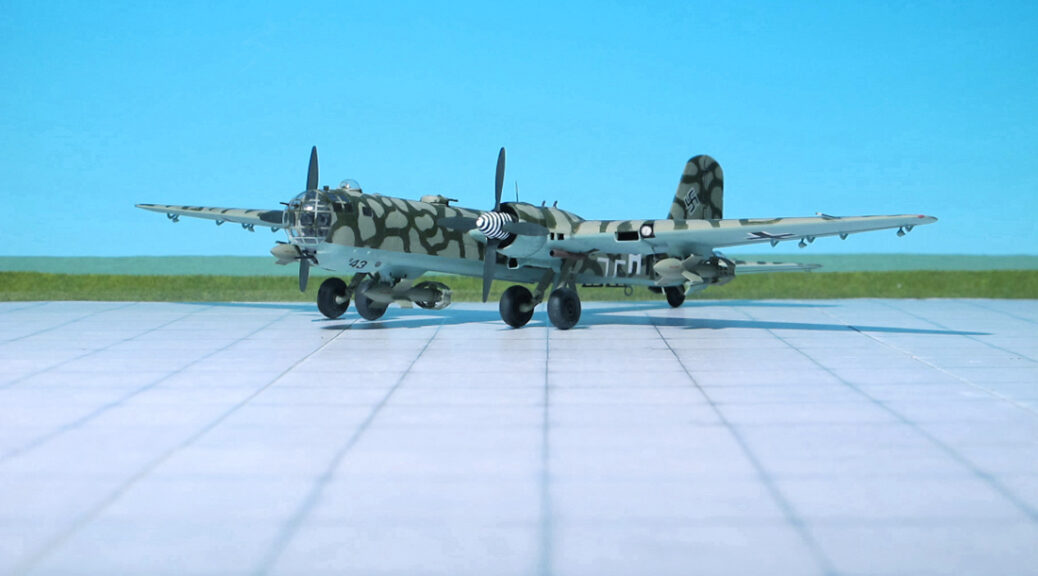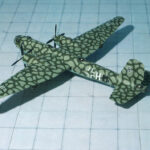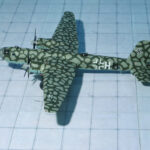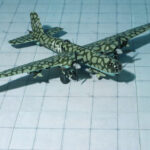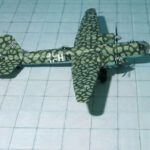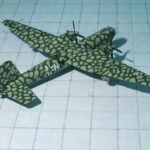TYPE: Heavy long-range bomber
ACCOMMODATION: Crew of 6
POWER PLANT: Two Daimler- Benz DB 610 “power systems”, each one created from a twinned-pair of Daimler-Benz DB 610A-1/B-1 liquid-cooled engines, rated at 2,950 hp each
PERFORMANCE: 303 mph at 19,685 ft
COMMENT: The Heinkel He 177 “Greif” (“Griffin”) was a long-range heavy bomber flown by the German Luftwaffe during World War II. The He 177 was the only operational long-range heavy bomber available to the Luftwaffe during the war years that had a payload/range capability similar to the four-engined heavy bombers flown by the USAAF and RAF in the European theatre; it had higher cruising and maximum speeds.
Designed to a 1936 requirement known as “Bomber A”, the aircraft was originally intended to be a purely strategic bomber intended to support a long-term bombing campaign against Soviet industry in the Urals. In spite of its large wingspan, the design was limited to two engines. During the design, Luftwaffe doctrine came to stress the use of moderate-angle dive-bombing, or “glide bombing”, to improve accuracy. Applying the changes needed for this type of attack to such a large aircraft was unrealistic.
To deliver the power required from only two engines on an aircraft this large, engines of at least 2,000 hp were needed. Such designs were not well established and the Daimler-Benz DB 606 “power system”, combined with the cooling and maintenance problems caused by the tight nacelles, caused the engines to be infamous for catching fire in flight. Early models gained the nicknames Reichsfeuerzeug“ (“Reich’s lighter”) from Luftwaffe aircrew.
On 9 November 1939, the first prototype, the He 177 V1, was flown. Further seven prototypes were completed until 1942, followed by 35 pre-production He 177 A-0s and 130 He 177 A-1s. The early aircraft in this batch were used for further trials, and after a brief and unhappy operational debut the remainder were withdrawn from service. From late 1942 they were replaced by He 177 A-3s. Starting in August 1943, all He 177’s delivered had an extended rear to both instill greater stability for bombing and to offset the slightly lengthened engine nacelles. Most of the short-fuselage A-3s were rebuilt to the longer standard . From November 1942 to June 1944 612 He 177A-3 were built resp. converted (from short fuselage to long fuselage). These were followed by 350 He 177A-5.
The type matured into a usable design but was too late in the war to play an important role. It was built and used in some numbers, especially on the Eastern Front where its range and cruising altitudes in excess of 19,690 ft was particularly useful. So, losses were relatively light. The Soviet Air Force, equipped mainly for low-level interception and ground-attack roles, could do little to hinder the high-flying bombers. In contrast the He 177 saw considerably less use on the Western Front late in 1944.
As the war progressed, He 177 operations became increasingly ineffective. Fuel and personnel shortages presented difficulties, and He 177s were sitting on airfields all over Europe awaiting new engines or engine-related modifications. Constant attacks of the Allied against Luftwaffe long-range combat units in France made continuous operations difficult.
In common with most piston-engined German bombers, the He 177 was grounded from the summer of 1944 due to the implementation of the Emergency Fighter Program (Jäger Notprogramm). Until November 1944, 1,153 He 177 in several subtypes were built by Arado and Heinkel.
One Heinkel He 177A-0, one A-3, and two A-5 were rebuilt as Heinkel He 177 B prototypes from December 1943 to July 1944. From the beginning these aircraft were designed as a four-engined development with four Daimler-Benz DB 603 in separate nacelles instead of the “coupled engine” powered He 177 A-series. Further plans show that these engine arrangements were postulated for the successor, the Heinkel He 277.
The Heinkel He 177 A-5/R2, shown here, belongs to the 4./KG 100, stationed at Chateaudun, France. This version was optimized for Ruhrstahl Fritz X and Henschel Hs 293 guided bombs and equipped with FuG 203 Kehl-Straßburg control gear.
RUHRSTAHL FRITZ X
Ruhrstahl Fritz X was the most common name for a German guided anti-ship glide bomb used during WWII. Fritz X was the world’s first precision guided weapon deployed in combat and the first to sink a ship in combat. Fritz X was a nickname used both by Allied and German Luftwaffe personnel. Alternative names include Ruhrstahl SD 1400 X, Kramer X-1, PC 1400X or FX 1400 (the latter, along with the unguided PC 1400 Fritz nickname, is the origin for the name “Fritz X”.
Fritz X was a further development of the PC 1400 (Panzersprengbombe, Cylindrisch 1,400 kg) armour-piercing high-explosive bomb, itself bearing the nickname Fritz. It was a penetration weapon intended to be used against armored targets such as heavy cruisers and battleships. It was given a more aerodynamic nose, four stub wings, and a box shaped tail unit consisting of a roughly 12-sided annular set of fixed surfaces and a cruciform tail with thick surfaces within the annulus, which contained the Fritz X‘s aerodynamic controls.
The Luftwaffe recognized the difficulty of hitting moving ships during the Spanish Civil War. Dipl. engineer Max Kramer, who worked at the Deutsche Versuchsanstalt für Luftfahrt (DVL) had been experimenting since 1938 with remote-controlled free-falling 250 kg bombs and in 1939 fitted radio-controlled spoilers. In 1940, Ruhrstahl AG was invited to join the development, since they already had experience in the development and production of unguided bombs.
Fritz X was guided by a FuG 203 Kehl-Straßburg radio control link, which sent signals to the movable spoilers in the thick vertical and horizontal tail fin surfaces, within the annular tail fin structure. This control system was also used for the unarmored, rocket-boosted Henschel Hs 293 anti-ship ordnance, itself first deployed on 25 August 1943. The Kehl-Straßburg receiver antenna installations on the Fritz X were aerodynamically integrated into the trailing edge of the annular surfaces of the tail fin, non-metallically encapsulated within a quartet of “bulged” sections in the trailing edge. This design feature of the FuG 230 Kehl-Straßburg receiver installation is not entirely unlike the Azon (Azimuth only ) US contemporary guided bomb, which had its own receiving antennas placed in the quartet of diagonal struts bracing the fixed sections of its tail fins.
Minimum launch height was 13,000 ft – although 18,000 ft was preferred – and a range of 5 km was necessary. As it was an MCLOS (manual command to line of sight)-guidance ordnance design, the operator had to keep the bomb in sight at all times (a tail flare was provided, as with the Azon, to assist the operator in tracking the weapon) and the control aircraft had to hold course, which made evading gunfire or fighters impossible. Approximately 1,400 examples, including trial models, were produced (Ref.: 24).
